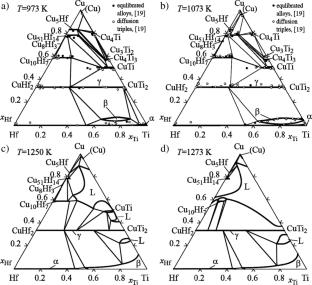In the framework of the CALPHAD method, the thermodynamic assessment of the Cu–Ti–Hf system has been performed for the first time. This assessment considers the existence of homogeneity regions for Cu3Ti2, Cu4Ti3, CuTi, Cu5Hf, Cu51Hf14, and Cu10Hf7 compounds and the formation of a continuous solid solution of Cu(Ti, Hf)2 (γ-phase) in the ternary system. The thermodynamic assessments of the boundary binary systems and data on phase transformations and mixing enthalpy of melts in the ternary system became the basis for calculations. The Compound Energy Formalism was used to model the thermodynamic properties of intermetallic compounds with a homogeneity region. The associated solution model was used to describe the complex temperature dependence of the thermodynamic properties of melts from the temperature at which equilibrium melts exist to the glass-formation temperature. Upon the calculations, isothermal sections, vertical sections, projections of the liquidus and solidus surfaces, and reaction scheme of the phase diagram were presented. The liquid phase participates in eleven four-phase invariant reactions occurring in the temperature range 1138–1541 K. The diagrams of metastable phase transformations involving supercooled Cu–Ti–Hf melts and boundary solid solutions based on pure components were calculated. It is shown that supercooled melts in wide concentration ranges are thermodynamically stable in relation to boundary solid solutions based on pure components. The concentration region of glass formation for Cu–Ti–Hf melts by liquid quenching, predicted by the relative position of the \({T}_{0}^{L/\phi }\) and \({x}_{0}^{L/\phi }\) lines, is xCu ≈ 0.16–0.80.



